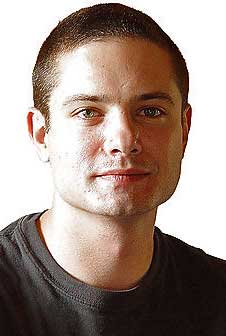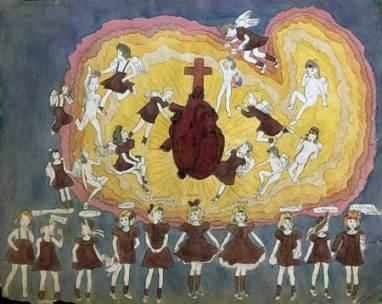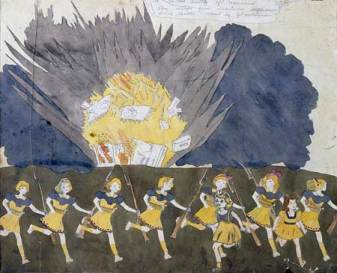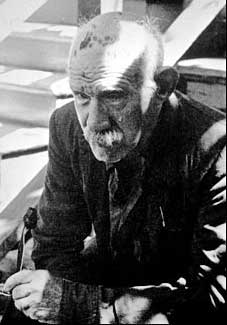By Stephen Brookes
The Washington Post September 30, 2007
(Note: this is a longer version of an interview with Jefferson Friedman that ran in The Washington Post on Sunday. For that version, please click here.)

Jefferson Friedman
When an aging janitor and onetime mental patient named Henry Darger moved out of his Chicago boardinghouse in 1971, his landlord discovered a bizarre legacy -- a 15,000-page novel and hundreds of paintings, all depicting a war on a distant planet between children and a regime that enslaves, tortures and kills them.
The novel -- titled The story of the Vivian Girls, in what is Known as the Realms of the Unreal – is a sprawling, often violent work. But it’s Darger’s paintings that have attracted the most attention, both for their bizarre subject matter and naïve, unschooled beauty, and he’s widely recognized as an important American artist. Thursday through Saturday at the Kennedy Center, the National Symphony Orchestra will be performing an orchestral work based on one of Darger’s most intense paintings, a diptych entitled “Sacred Heart: Explosion.”
We talked with composer Jefferson Friedman, 32, about his new work (which is part of a trilogy based on “outsider” artists titled "In the Realms of the Unreal") and his thoughts on one of the 20th Century’s most controversial painters.
Darger spent his life alone, in poverty, dealing with some pretty frightening personal demons. What drew you to him?
I think that most people who create, whether they're "outsider" or not, are trying to grapple with their inner demons. When I'm composing, I'm trying to get something from the inside to the outside. With Darger, it's just a more extreme case.
Sure -- but a lot of his art is seriously disturbing: a group of little girls who get tortured and abused, usually without any clothes on. And most of them are drawn with penises. Weren't you a little ... creeped out?
Of course! It's definitely disturbing stuff. These scenes are definitely graphic and weird, but -- at least in his mind -- he was the savior to these children. He was trying to protect them from evil forces. Who knows what it was in his background that caused him to want to be that -- it's all speculation.

Sacred Heart: Explosion (part one of the diptychDo you think he was insane?
I think maybe "eccentric" is a better word. I doubt he ever molested children or anything like that; it's entirely possible that he used this as an obsessive outlet to control those impulses. But was he insane? On the continuum of insanity, he was probably skewed toward one end of the scale.
Darger always seems to be pitting his spiritual side against his dark, "glandular" side. Is there something universal in this?
Well, I think there's something redeeming to what he did, or I wouldn't have decided to write a piece about it. It definitely has social value. And the intention of the artist is something that's always up for debate. But when I first saw his work, I was completely blown away.

Sacred Heart: Explosion (part two of the diptych)
Why did you pick this particular painting?
This is rather a unique painting for Darger; it has a certain amount of formalism to it that the others don’t.
And what attracted me to it is the abstraction -- the others are more narrative and straightforward. This one abstracts his ideas, and encompasses what he’s trying to do with his whole work.
If I were going to write a book on Darger I’d use this painting as the cover.
In your earlier piece on James Hampton, you took some compositional cues from the artist's own techniques. Did you do this with Darger, too?
Yes, to a certain extent; there's a huge amount of detail, obsessive detail, applied to every note in this piece, and I felt like I was channeling Darger's process in that way.
Darger also copied pop images into his paintings -- things like Coppertone ads.
Sure; Darger traced in images, so I traced a hymn into Sacred Heart: Explosion in the same way he traced a heart from some medical text. And the formal aspect of the piece I wrote mimics the formal aspect of the painting. My piece is in two parts, like the painting; the hymn that's presented in the first half is exploded in the second half.
Other serious composers -- people like Wolfgang Rihm and Terry Riley -- have also been building on the work of outsider artists. Do you see a trend?
I don't know -- but it's interesting, the connection that musicians feel for outsider art.

Henry Darger Why is that?
With most outsider artists, there's a certain amount of purity to what they did. Since outsider artists aren't trying to make any sort of commentary, their work functions more as a blank canvas for musicians. And then, writing a piece of orchestral music is an extremely obsessive process -- there's a connection with the kind of focus and dedication you see in Darger's works.
There's also the fascination with visionaries; in a lot of cultures, people thought the insane had a direct pipeline to God.
Sure -- there’s certainly a long tradition of outsider artists who incorporate religious iconography into their work, and in fact that’s one of the requirements for artists for me, that I’m working on; they have to be American-born, they have to be outsider or visionary artists, and they have to have incorporated Christian iconography into their work. Speaking in tongues, particularly intense religious devotion, is not that far off from what these artists have done. They've just done it in a more unique and special way. For me, music is the closest thing I've come to in terms of spirituality. It comes back to the idea of artistic purity. I think all these concepts are linked to one another.
So, do you see yourself as a sort of interlocutor between people like Darger and the rest of us?
I suppose. I’m definitely trying to spread the gospel of these guys – they deserve to be much better known than they are. These pieces are not tongue-in-cheek in any way; they’re done with the utmost respect for these artists. They're meant to be an homage to what they've accomplished. It’s a beautiful thing to me.
Would you ever do a piece based on the work of an outsider musician? Someone like Moondog, say, or … Tiny Tim?
The distance that I have, as a musician, to the visual artist is why it works; for musical outsider artists, it’s almost too close. So I don’t think I would, no. Translating these visual images into the language of music is the process that makes this work.
You still have one more part of the trilogy to write; how’s it coming?
The current timeline is for 2010 -- hopefully. It’ll be nice when it’s done.